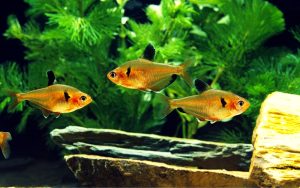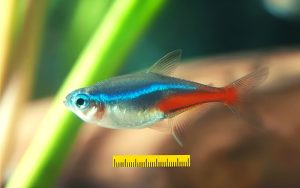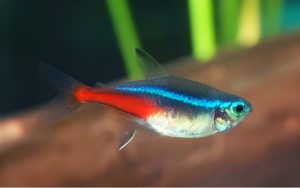Ghost shrimp are a popular freshwater aquarium species known for their hardiness and low-maintenance care. However, one thing that all ghost shrimp owners should know about is their molting process. But how often do ghost shrimp molt?
Molting is a natural process that all crustaceans go through to grow and develop.
In the case of ghost shrimp, they will molt regularly, typically every 3 to 4 weeks for adults and every 1 to 2 weeks for juveniles.
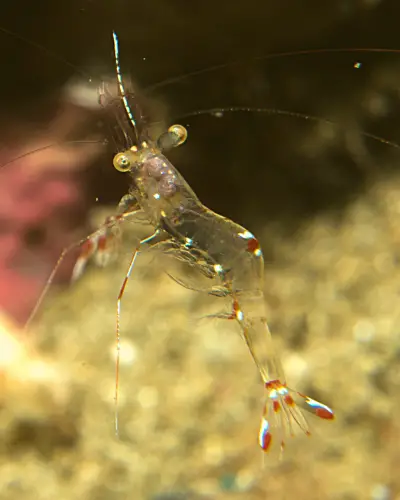
The molting process is delicate, and it is essential to provide your ghost shrimp with a safe and stable environment during this time. If your ghost shrimp is molting, avoid disturbing them and keep the tank water quality high. Understanding the molting process can help your ghost shrimp thrive and live a long and healthy life.
Table of Contents
ToggleHow Often Do Ghost Shrimp Molt?
How often do ghost shrimp shed their skin? Ghost shrimp, like all crustaceans, molt to facilitate growth. They periodically shed their exoskeleton, the hard outer shell, and replace it with a new, larger one. The frequency of molting varies depending on several factors, including age, environment, and diet.
Younger Ghost Shrimp: Baby shrimp tend to molt more frequently than adults. This is because they experience rapid growth during their early stages of life. Sometimes, they may molt every few days to accommodate their growing bodies.
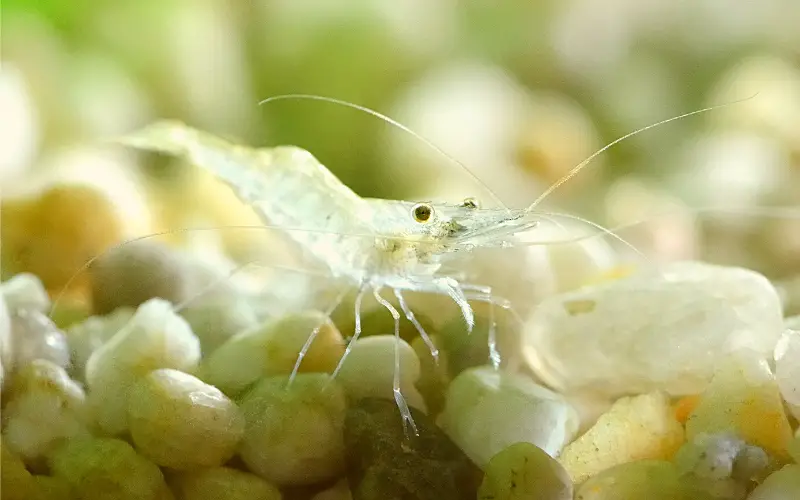
Adult Ghost Shrimp: Their molting frequency typically decreases as ghost shrimp mature. Adult shrimp will molt every few weeks to months. The frequency can be influenced by water quality, temperature, and food availability.
Here are some additional tips for helping your ghost shrimp during the molting process:
- Provide plenty of hiding places for your shrimp to molt in peace.
- Keep the water temperature and pH stable.
- Avoid adding new chemicals or medications to the tank during molting.
- Monitor your shrimp closely for any signs of trouble.
Following these tips can help your ghost shrimp molt safely and successfully.
Is Your Ghost Shrimp Molting or Dead?
There are a few ways to tell shrimp keeper if your ghost shrimp is molting or dead.
- Look for a transparent, empty exoskeleton. When a shrimp molts, it leaves behind its old exoskeleton. This exoskeleton will be clear and empty and may be found floating in the tank or attached to the substrate.
- Check the shrimp’s body. If the shrimp’s body is soft and white, it is molting. If the shrimp’s body is complex and opaque, it is dead.
- Look for signs of activity. A molting shrimp will be very still and may appear to be asleep. A dead shrimp will not move or respond to stimuli.
Here are some additional signs that your ghost shrimp may be dead:
- The shrimp’s body parts will be sunken or shriveled.
- The shrimp’s eyes will be cloudy or sunken.
- The shrimp’s antennae will be limp or broken.
- The shrimp will have a foul odor.
If you are unsure whether your ghost shrimp is molting or dead, it is best to err on caution and assume it is dead. Dead shrimp can release toxins into the water, so removing them from the tank as soon as possible is crucial.
Here are some tips to help prevent your ghost shrimp from dying:
- Provide a clean and well-oxygenated tank.
- Use a substrate that is soft and easy for shrimp to burrow in.
- Feed your shrimp a varied diet of live, frozen, and flake food.
- Maintain the proper water temperature and pH levels.
- Quarantine new shrimp before adding them to your tank.
Following these tips can help keep your ghost shrimp healthy and happy.
Signs of Successful Molting
Successful molting positively indicates your ghost shrimp’s health and growth. Here are some signs to look for during the molting process:
- Whitening of Exoskeleton: The shrimp’s exoskeleton may appear pale or translucent just before molting. This indicates that the old exoskeleton is separating from the body.
- Inactive Behavior: During molting, ghost shrimp often become less active and may hide in secluded areas of the aquarium. This is normal behavior as they are vulnerable without their protective shell.
- Empty Exoskeleton: After a successful molt, you may find an empty exoskeleton in the aquarium. This delicate structure is a testament to the shrimp’s growth.
Signs of Unsuccessful Molting
While molting is a natural process, there are instances where it can go awry. Unsuccessful molting can have severe consequences for your ghost shrimp. Here are signs to watch out for:
- Stuck Exoskeleton: Sometimes, ghost shrimp can get stuck while trying to shed their exoskeleton. If not addressed promptly, this can result in injury, lost limbs, or death.
- Floatation Issues: Shrimp struggling to swim or float after molting may have difficulty shedding their old exoskeleton, leading to health problems.
- Dull Coloration: If the process is unsuccessful, a shrimp’s color may appear dull or faded after molting. This is a sign of stress and potential health issues.
Essential Care Tips for Ghost Shrimp Molting
To ensure the health and successful molting of your ghost shrimp, consider the following care tips:
- Water Quality: Maintaining proper water conditions is crucial. Glass shrimp are sensitive to changes in water parameters, so regular monitoring and water changes are essential. Avoid sudden fluctuations in temperature, pH, and ammonia levels.
- Diet and Nutrition: Provide a balanced diet rich in proteins and calcium. These nutrients are essential for the formation of a strong exoskeleton. Offer a variety of foods, including high-quality pellets and blanched vegetables.
- Avoid Overcrowding: Ghost shrimp need adequate space to molt comfortably. Overcrowded tanks can lead to stress and molting issues. Ensure that the tank size suits the number of shrimp you have.
- Provide Hiding Places: Furnish the aquarium with plenty of hiding spots, such as plants, rocks, and caves. During molting, ghost shrimp become more vulnerable, and hiding places offer protection from potential threats.
- Monitor Molting Shrimp: Keep a close eye on shrimp that are molting. If you notice a shrimp struggling to shed its exoskeleton or becoming stuck, consider gently assisting it or providing a safe environment.
How To Know When a Ghost Shrimp Is Molting?
Like other shrimp species, ghost shrimp undergo a molting process as they grow. Molting is a natural and essential part of their life cycle. During this process, the shrimp shed their old exoskeleton and form a new, larger one. Here are some signs to look out for to determine if your ghost shrimp is molting:
- Behavioral Changes: Shrimp ready to molt may become less active and hide more than usual. It might spend more time in its hiding spots and avoid interactions with other tank inhabitants.
- Faded Coloration: Many Ghost shrimp may appear slightly dull or faded in color before molting. This could be due to separating the old exoskeleton from the body underneath.
- Ghost Shrimp Turning White: One of the most noticeable signs of molting is the shrimp’s color change. Just before molting, a ghost shrimp may turn pale or even white. This change in coloration indicates that the old exoskeleton is detaching from the shrimp body.
- Hunched Back: As the shrimp prepares to molt, its back might become more arched or hunched. This results from the old exoskeleton separating from the body and creating space for the new exoskeleton to form.
- Opaque Appearance: As molting begins, you might notice the ghost shrimp’s body becoming more opaque or cloudy. This is a result of the new exoskeleton forming underneath the old one.
- Hiding Behavior: Ghost shrimp are known to hide during molting to protect themselves while they are vulnerable without their hard exoskeleton. Providing ample hiding spots in the aquarium is vital to reduce stress during this time.
- Post-Molt Behavior: The shrimp’s exoskeleton will be left behind in the tank after molting. The shrimp often consume parts of its old exoskeleton to regain lost nutrients. You might also notice the newly molted shrimp becoming more active and exploring its environment.
It’s essential to create a suitable environment for molting to occur smoothly. Ensure your aquarium has proper water quality, sufficient hiding places, and a balanced diet for the ghost shrimp. Avoid disturbing the shrimp during the molting process, as they can be vulnerable now.
Remember that molting is natural, and not all ghost shrimp will molt simultaneously. Some shrimp may molt more frequently than others. Monitoring their behavior and appearance will help you identify when a ghost shrimp is molting and ensure their well-being during this essential life cycle phase.
How Long Does It Take Ghost Shrimp to Molt?
how long does it take for ghost shrimp to molt? Like other shrimp species, ghost shrimp undergo molting as part of their growth process. Molting is the shedding of their exoskeleton to accommodate their increasing size.
The time it takes for ghost shrimp to molt can vary depending on age, size, and environmental conditions. On average, ghost shrimp can take a few hours to a couple of days to complete the molting process.
During molting, the shrimp will retreat to a secure hiding place to protect itself while its exoskeleton becomes soft and vulnerable. The old exoskeleton will eventually crack, and the shrimp will emerge, revealing a new, more giant exoskeleton. The newly molted shrimp may appear pale and slightly translucent until its exoskeleton hardens.
It’s worth noting that the molting process is especially crucial for pregnant female shrimp as they need to shed their exoskeleton to release eggs. After molting, female ghost shrimp will have a receptive period where male shrimp can fertilize them.
Regarding feeding, shrimp, including ghost shrimp, typically eat their discarded exoskeleton after molting. The exoskeleton provides valuable nutrients, including calcium, essential for forming the new exoskeleton.
Additionally, shrimp will consume algae, detritus, and other tiny organisms in their environment as part of their diet.
It’s important to mention that ghost shrimp are a specific species (Palaemonetes paludosus) and should not be confused with Amano shrimp (Caridina multidentata). These are two different types of shrimp with distinct characteristics and care requirements.
Can Shrimp Die from Molting?
Yes, shrimp can die from molting. Molting is a natural process that allows shrimp to grow but can be dangerous. When a shrimp molts, it sheds its old exoskeleton and grows a new one.
This process leaves the shrimp vulnerable to predators and other dangers. If the shrimp is not able to molt successfully, it can die.
There are a few things that can go wrong during molting. The shrimp’s new exoskeleton may not harden properly, or the shrimp may not be able to escape from its old exoskeleton. If this happens, the shrimp will be unable to breathe or move properly and eventually die.
There are a few things that you can do to help prevent shrimp from dying during molting:
- Make sure that the water temperature is correct. Shrimp molt best at temperatures between 70 and 78 degrees Fahrenheit.
- Provide plenty of hideouts for the shrimp. This will give them a place to hide while they are molting.
- Avoid adding new fish or chemicals to the tank during molting.
If you see a molting shrimp, it is vital to monitor it closely. You should take action immediately if you notice any problems, such as the shrimp’s inability to escape from its old exoskeleton.
You can try to help the shrimp by gently peeling off its old exoskeleton. If this is not successful, you may need to euthanize the shrimp.
Here are some additional tips to help prevent shrimp from dying during molting:
- Feed the shrimp a high-quality diet that is rich in calcium. Calcium is vital for the formation of the new exoskeleton.
- Keep the water quality in the tank high. This will help prevent the shrimp from becoming stressed, making molting more difficult.
- Do not disturb the shrimp during molting. This can stress them out and make them more likely to die.
By following these tips, you can help to ensure that your shrimp molt successfully and avoid dying.
What Are the Consequences of the Unsuccessful Molting Process?
The unsuccessful molting process can have significant consequences for shrimp. Molting is when a shrimp sheds its old exoskeleton to grow a new one. However, if the molting process is unsuccessful, it can lead to various issues.
Ghost shrimp, for example, need to molt regularly to grow and maintain their exoskeleton. With successful molting, these shrimp may grow properly and may even become stunted in size.
Furthermore, a shrimp with an unsuccessful molt may end up with two disconnected exoskeletons, making them more vulnerable to predators and the environment. This might lead to increased stress levels and reduced survival rates for these shrimp.
Therefore, the consequences of an unsuccessful molting process can severely affect the health of shrimp.
Why Do Most Molting Processes Fail?
While molting is a regular occurrence, several factors can contribute to molting issues and failures in shrimp tanks. Here’s why most molting processes fail and how you can ensure healthy molting for your ghost shrimp:
- Water Quality: Maintaining proper water parameters is essential for successful molting. Poor water quality, with high ammonia, nitrites, or nitrates, can stress the shrimp and disrupt the molting process. Regular tank water testing and partial water changes are vital to optimize your ghost shrimp tank conditions.
- Mineral Deficiencies: Shrimp require minerals, especially calcium, to form their new exoskeleton after molting. Inadequate mineral content in the water can lead to soft or incomplete shells, making the molting process difficult and risky. Provide a source of calcium, such as crushed coral or specialized shrimp supplements, to ensure your ghost shrimp have access to essential minerals.
- Diet and Nutrition: A Varied diet is crucial for healthy molting. Feeding your ghost shrimp a varied diet of high-quality foods, including shrimp pellets, algae, and blanched vegetables, ensures they receive the necessary nutrients for proper growth and molting. Inadequate nutrition can weaken shrimp, making them more susceptible to molting issues.
- Overcrowding: Too many shrimp in a tank can increase competition for resources, stress, and aggression. Overcrowding can hinder the molting process, resulting in failed molts or even a white ring of death. Maintain an appropriate shrimp-to-tank size ratio to reduce stress and ensure each shrimp has enough space.
- Age and Health of Shrimp: Younger shrimp may molt more frequently as they grow, and each molt increases the risk of complications. Additionally, older or weakened shrimp might struggle with molting due to reduced vitality. Providing optimal care and addressing health concerns promptly can improve the molting success rate.
- Temperature Fluctuations: Sudden temperature changes or extremes can disrupt the molting process. Maintain a stable and suitable temperature range for your ghost shrimp to prevent shocks that could lead to failed molts.
- Molting Process Disturbance: Handling or disturbing shrimp during molting can lead to injury or unsuccessful molts. Avoid unnecessary disturbances in the tank and provide hiding spots like plants or decorations to offer your shrimp a safe space during molting.
To ensure your ghost shrimp have the best chance of a successful molting process, maintain pristine water quality, provide adequate minerals and nutrition, avoid overcrowding, monitor the health of your shrimp, regulate tank temperature, and minimize disturbances during molting.
Addressing these factors can increase the likelihood of healthy molting and overall well-being for your ghost shrimp population.
FAQs about Ghost Shrimp Molting
Can ghost shrimp die from molting?
Yes, improper molting can be fatal for ghost shrimp. It’s important to create an environment conducive to successful molting.
How can I tell if my ghost shrimp is ready to molt?
Look for signs like increased hiding, decreased activity, and a whitening exoskeleton to determine if your shrimp is preparing to molt.
What is the ghost shrimp molting process?
Molting is when a shrimp sheds its old exoskeleton and replaces it with a new one. During this process, the shrimp’s body becomes soft and vulnerable.
Why is molting essential for ghost shrimp?
Molting is essential for the growth and development of ghost shrimp. It allows them to discard their old exoskeleton, and shrimp grow larger to accommodate their increasing size.
How long does the molting period last?
The ghost shrimp molting period usually lasts a few hours to a couple of days. During this time, the shrimp will be more vulnerable and may hide or become inactive.
How can I tell if my ghost shrimp is going to molt?
Ghost shrimp preparing to molt may appear less active and spend more time standing still. You may also notice a whitish coloration or cloudy appearance on their body.
What should I do during the molting process?
During the molting process, providing a safe and stress-free environment for the ghost shrimp is essential. Avoid disturbing or handling them, as it can interfere with the molting process.
What should I feed my ghost shrimp during molting?
Ghost shrimp may not eat during the molting process as their appetite decreases. However, you can provide them with small amounts of high-quality shrimp food to ensure they have access to nourishment if needed.
Can I keep ghost shrimp in a community tank with other shrimp species?
Ghost shrimp can be kept in a community tank with other shrimp species, such as glass or cherry shrimp, as long as the tank is large enough and has suitable water conditions for all the shrimp.
How do I create ideal water conditions for my ghost shrimp?
Maintaining stable water parameters for your ghost shrimp, including temperature, pH, and ammonia levels, is essential. Regular water changes and reliable water conditioners are essential for their well-being.
Are there any precautions I should take when keeping ghost shrimp?
Avoid keeping your ghost shrimp with larger, aggressive fish tank mates, as they may become prey. Also, make sure the tank has plenty of hiding places and suitable substrate for the shrimp to molt and explore.
How many times do ghost shrimp molt?
Ghost shrimp molt several times throughout their lives. The exact number of times they molt can vary, but on average, they molt around 6 to 10 times before adulthood.
Conclusion
So, how often do ghost shrimp molt? Ghost shrimp are fascinating creatures that are relatively easy to care for. One of the most essential things about ghost shrimp is how often they molt. Generally, healthy adult ghost shrimp will molt every 3 to 4 weeks. Younger ghost shrimp will molt more often, perhaps every 1 to 2 weeks. The molting process is a natural part of a ghost shrimp’s growth, and it is crucial to provide them with a safe and stable environment during this time. If you are concerned about your ghost shrimp’s molting, you can do a few things.
First, make sure that your water parameters are correct. Ghost shrimp prefer soft, acidic water with a pH of 6.5 to 7.5. Second, provide them with a diet high in calcium and other nutrients. This will help them to grow strong and healthy shrimp shells. Finally, be patient. Molting can be stressful for ghost shrimp, so giving them time to adjust to their new shell is essential. Several resources are available online if you want to learn more about ghost shrimp molting. You can also consult with a reputable aquarium store or breeder. You can help your ghost shrimp molt safely and successfully with some knowledge.
You might also like
- Are Ghost Shrimp Neocaridina: Ghost Shrimp vs Cherry Shrimp
- Male vs Female Ghost Shrimp: 7 Key Differences You’ll love
- Ghost Shrimp Turning Brown – 5 Causes & Proven Solutions
- Ghost Shrimp Turning White: 7 Reasons & Proven Curing Tips
- Do Ghost Shrimp Lay Eggs: What to Expect and What to Do?
- Where Do Ghost Shrimp Lay Eggs: (5 Surprising Locations!)
- Ghost Shrimp Water Temp: Expert Care Guide For Beginners
- Amano Shrimp Vs Ghost Shrimp: A Comprehensive Comparison
- Water Parameters Needed for Ghost Shrimp: The 7 Keys to Shrimp Success
- Ghost Shrimp Fish Tank Mates: The 10 Best (And Worst) Choices
- Ghost Shrimp Molting or Dead: 1 Remarkable Molting Comeback!
- Why Do My Ghost Shrimp Keep Dying: (5 Reasons & Quick Fixes)
- Does Shrimp Shed Their Skin? 3 Surprising Facts About Molting!


